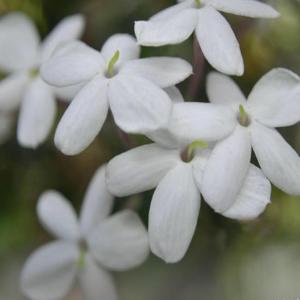
ROYAL JASMINE BLOSSOMS (JASMINUM GRANDIFLORUM) - PLANTS

BASE / GENERAL DATA
Information submited: May 15, 2015 Modified: May 16, 2018 By: OperaDreamhouse
It is widely cultivated as an ornamental plant in warm temperate and subtropical regions. The term Jasmine is probably derived from Persian word Yasmine meaning "Fragrance", which is adopted in Arabic as Yasym given to Jasmine Flowers.
Jasminum Grandiflorum, also known variously as the Spanish Jasmine, Royal Jasmine, Catalonian Jasmine, is a species of Jasmine native to South Asia (Nepal, Kashmir, and Northern Pakistan), the Arabian Peninsula (Oman, Saudi Arabia), Northeast Africa (Eritrea, Ethiopia, Djibouti, Somalia, Sudan), the African Great Lakes (Kenya, Uganda, Rwanda), and the Yunnan and Sichuan regions of China.
The plant is known as "Saman Pichcha" or "Pichcha" in Sri Lanka. Buddhist and Hindu temples use these flowers in abundance.
It is a scrambling deciduous shrub growing to 2 - 4 m tall. The leaves are opposite, 5 - 12 cm long, pinnate with 5 - 11 leaflets. The flowers are produced in open cymes, the individual flowers are white having corolla with a basal tube 13 - 25 mm long and five lobes 13 - 22 mm long. The flower's fragrance is unique and sweet. The flowers open at night, and close in the morning.
The bulk of the flowers are used as such in garlands and decorative branches for religious offerings, and a small quantity is used for production of oils and attars.
Jasminum Grandiflorum, also known variously as the Spanish Jasmine, Royal Jasmine, Catalonian Jasmine, is a species of Jasmine native to South Asia (Nepal, Kashmir, and Northern Pakistan), the Arabian Peninsula (Oman, Saudi Arabia), Northeast Africa (Eritrea, Ethiopia, Djibouti, Somalia, Sudan), the African Great Lakes (Kenya, Uganda, Rwanda), and the Yunnan and Sichuan regions of China.
The plant is known as "Saman Pichcha" or "Pichcha" in Sri Lanka. Buddhist and Hindu temples use these flowers in abundance.
It is a scrambling deciduous shrub growing to 2 - 4 m tall. The leaves are opposite, 5 - 12 cm long, pinnate with 5 - 11 leaflets. The flowers are produced in open cymes, the individual flowers are white having corolla with a basal tube 13 - 25 mm long and five lobes 13 - 22 mm long. The flower's fragrance is unique and sweet. The flowers open at night, and close in the morning.
The bulk of the flowers are used as such in garlands and decorative branches for religious offerings, and a small quantity is used for production of oils and attars.

SPIRITUAL PRACTISES DATA

MEDICINE / HEALTH DATA

BEAUTY / COSMETICS DATA

FOOD / COOKING DATA
COMMENTS
No comments.


